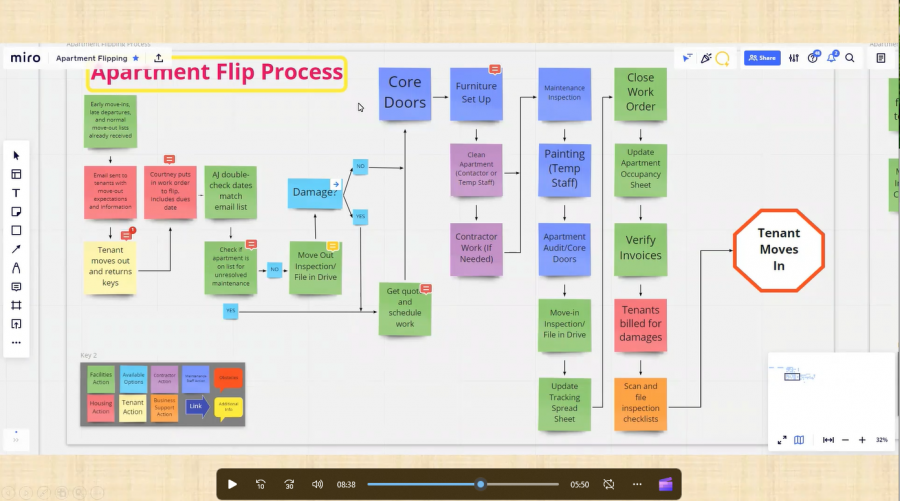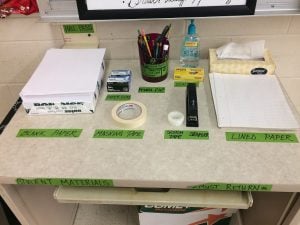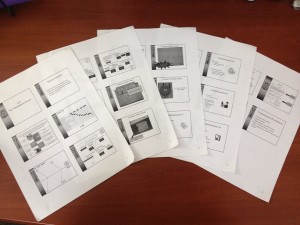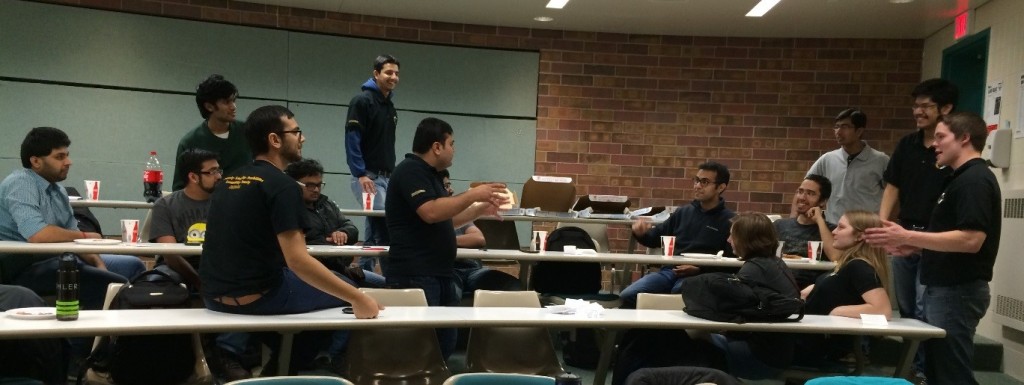AJ Mikus is the Facilities Manager for the Daniell Heights apartment complex at Michigan Technological University. AJ led an improvement event designed to improve the student experience of checking out of their apartments, reduce the amount of repairs needed, and ensure all damages were properly accounted for. Watch AJ’s report out on his kaizen experience at our Lean at Michigan Tech YouTube channel.
Ruth Archer is the Director of Continuous Improvement at Michigan Technological University.
We are pleased to present this guest blog post by Adam Wellstead, PhD, Associate Professor of Public Policy, Social Sciences at Michigan Technological University and 2019-2020 Faculty Fellow.
Every year, the Office of Continuous Improvement (OCI) undertakes a number of wide-ranging projects to make processes throughout our campus more efficient and effective. Often the project outcomes go unnoticed by a majority of the Michigan Tech community, including the bean counters. This contrasts with the manufacturing sector where Lean tools are applied to the creation of a tangible product, and costs/savings are meticulously tracked. Michigan Tech is a highly complex multiple million dollar business (of higher education), and OCI projects have improved safety and reduced waste. However, the accrued financial benefits are largely invisible because the current cost to the university for most of its processes is not documented. This year, I was a Faculty Fellow working with the OCI and one of my projects was to account for these costs.
Other universities who employ Lean methods and tools also struggle to show the financial benefits. One possible approach to account for these invisible benefits of Lean in a system that does not closely track expenses is to apply counterfactual thinking. This approach has played an important role in the efforts of social scientists, particularly historians, to assess causal hypotheses. By making claims about events that did not actually occur, counterfactuals play a necessary and fundamental, if often implicit and underdeveloped, role in the efforts to assess the hypotheses about the causes of a phenomena.
A well-known example is, had George W. Bush not been elected, would the Iraq war have occurred? Counterfactual analysis makes causal claims about events that did not actually occur; that is, non-observations. Social scientists have developed well-established criteria for judging counterfactual arguments (Table 1). For example, we cannot make implausible counterfactual claims. Looking at the Bush-Iraq War case, had George Bush not been elected, it is implausible to claim that Iraq would have been become a fully democratic country.
| Table 1 | Criteria Checklist for Judging Counterfactual Scenarios |
| Criteria | Description |
| Clarity | Specify and circumscribe the independent and dependent variables (the hypothesized antecedent and consequent) |
| Logical consistency | Specify connecting principles that link the antecedent with the consequent and that are cotenable with each and with the antecedent |
| Historical consistency (minimal-rewrite rule) | Specify antecedents that require altering as few “well-established” historical facts as possible |
| Theoretical consistency | Articulate connecting principles that are as consistent with “well-established” historical facts as possible |
| Projectability | Tease out testable implications of the connecting principles and determine whether those hypotheses are consistent with additional real-world observations |
In the more modest world of Lean processes, we also can make a counterfactual causal claim about a non-observation, namely, what would have happened had the Lean process not been undertaken and what would have been the costs accrued by not addressing waste and inefficiencies? One recent OCI project highlights this approach. Daniel Heights has 52 buildings, all utilizing 1 of 13 different water heater pumps for circulating hot water to residents. This made it very hard to manage and keep records of the inventory for each pump type, brand, horsepower and orientation. Due to the amount of differentiation between the pumps, the process for reordering/replacing each pump lacked standardization and had many errors.
In 2019 standardization of pumps was implemented and an inventory of the pumps was taken. Now the shelves only contain needed pumps and are organized into a set space. Processes to perform inventory audits and reorder pumps are in place. The number of different brands of pumps being used for the water heaters in Daniel Heights went from 13 to two. They are also only using two different sizes of pumps when they were using five before. Table 2 lists the benefits that the project participants identified as well as the estimated yearly excessive costs of $8,461 had no action been taken (the counterfactual). The estimated value was determined by a deliberative process, keeping the criteria for judging counterfactual scenarios in mind, involving at least three OCI facilitators.
| Table 2 | Estimation of Excessive Costs Incurred by Michigan Tech |
| Area Improved from Standardization | Excessive Costs |
| Water Use/Efficiency | $100 |
| Storage Space | $286 |
| Time to Reorder | $375 |
| $ Tied up in Inventory | $4500 |
| Hrs. Recording Inventory | $270 |
| Staff Training for Pumps | $330 |
| Bulk Inventory | $2600 |
| Total $ Saved | $8,461 |
| Table 3 | Estimated Costs Incurred by Michigan Tech Over Five Years |
| Year | Net Present Value |
| 1 | $8,058.10 |
| 2 | $7,674.38 |
| 3 | $7,308.93 |
| 4 | $6,960.89 |
| 5 | $6,629.41 |
| Total | $36,631.70 |
This is an example of one fairly modest project. In the coming months, the OCI will implement this procedure for all of its projects being undertaken.
Michigan Tech will be a very different place this Fall, but one constant will be the continual need to root out waste and inefficiencies, and thereby reduce costs.
We are pleased to welcome Alexandra Holmstrom to the team in the Office of Continuous Improvement.
Hello,
I am Alexandra Holmstrom, the new Office Assistant in the Office of Continuous Improvement. I am very excited to be working at Michigan Tech and especially with all the highly dedicated and talented members of the OCI team!
I am new to Lean but as I learn more, I am realizing that I have been practicing many of the principles all along! I have always looked for ways to be more efficient and effective, thinking of ways to improve customer service, reduce costs, and remove unnecessary steps in day-to-day tasks.
There is much to learn and accomplish during my training, and I am eager to use all the newly acquired knowledge and skills. In the few short days I have been in the office, I have learned what Kaizen, PIC, PDCA, and Kanban stand for. If you are wondering what these words and acronyms mean, come see us in the office or visit us on our website.
I look forward to meeting and working with everyone on and off campus!
Thank you!
We are pleased to post this guest blog by Theresa Coleman-Kaiser, Senior Associate Vice President for Administration at Michigan Technological University.
I have been practicing online coaching using Lean principles and Kata concepts during short, frequent meetings for nearly six months. I started with finding my own coach who then guided me to begin and improve this practice. I now have six coachees that I am guiding to strengthen their own success and to improve Michigan Tech.
The coaching sessions were going really well, but they lacked any Visual Management element which is an important Lean tool that makes work visible. My coach encouraged me to figure out a way to incorporate Visual Management into my online coaching sessions. I created a video to explain how I used rapid experimentation through several PDCA cycles to implement Visual Management.
You can watch the video here: https://youtu.be/gEbf1aQTkMQ
I hope you enjoy learning from my experience. Do you have an effective way of using Visual Management using an online platform?
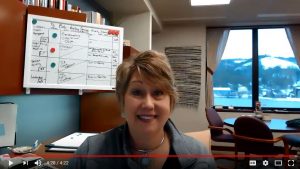
I was attending parent-teacher conferences at my daughter’s high school when I spotted some terrific visual management in the art teacher’s room. The teacher has to have supplies ready for new groups of students all day, without much time between classes to look for things. She’s developed a status-at-a-glance system that makes it easy for students to put things where they belong and easy for her to know if everything has been put away. Because I know about visual management, I could offer some simple improvement suggestions. Take a look at the picture below. What would you tell her?
Lean didn’t create visual management; Lean just provides a name for it. Naming becomes important because when you name it, you can define it, identify examples of it, repeat it, find best practices for it, and share it with others. I often see this when I teach people about Lean. They’re already using a lot of Lean ideas, and now they can fill in some gaps, place it inside a larger framework, have a common language for discussion, and follow a pathway to learning more.
What Lean tools were you using before you learned about Lean?
#Lean
We are pleased to present this guest blog post by Pete Baril, Health and Safety Manager at Michigan Technological University
Sort, Set in Order, Shine, Standardize, Sustain. We know it like the back of our hand. The 5S process is an excellent Lean tool for decluttering, organizing, and improving efficiency, but it can also be part of the foundation for another very important S, Safety.
We’ve all been there, either at home or at work, fumbling around in a cluttered mess trying to get something done. We trip, grab the wrong tool, or spill something; a virtual gauntlet of hazards placed before us simply due to a poorly maintained workspace. Poor housekeeping not only detracts from efficiency and progress, it’s also a safety problem.
Housekeeping is central to a safe and well-run workspace. In a previous life I was a health inspector, charged with evaluating restaurants on food safety and sanitation. I could tell within five minutes of entering a facility whether or not it was going to be a good day or a bad day, simply based on the organization and housekeeping of the operation. Currently, my professional focus is on safety, and when I evaluate a workspace the results are no different; poor organization and housekeeping almost always equal safety violations and unsafe work practices.
Keeping up with safety requirements can be daunting, and when operating in a poorly kept space, the problem is compounded. Give yourself a chance by practicing the 5S process throughout your workspace. Improved housekeeping can do wonders for your efficiency, not to mention your stress levels. An organized space promotes safety by providing clear workspaces free of trip hazards and poorly stored items. Good housekeeping also prevents us from having to use the wrong tool for the job, as the right one is no longer “lost.” In addition to the many other safety benefits of an organized space, good housekeeping practices demonstrate a level of control over the process that brings with it efficiency, pride, and an improved outlook on the task at hand. All this from something as basic as housekeeping.
In closing, please keep in mind, as you strive to become lean, also strive to improve safety. Your co-workers, clients, and family will appreciate it.
We are pleased to present this guest blog post by Heather Dunne, Digital Services Specialist for University Marketing and Communications at Michigan Technological University.
One of the common tools in Lean and continuous improvement is error proofing, or poka-yoke. Poka-yoke is a Japanese term that was developed and classified by Shigeo Shingo; that helps someone avoid (yokeru) mistakes (poka).
The concept is simple: Create countermeasures that guard against and prevent errors and mistakes from occurring in a process. If mistakes are avoided, the product quality is high, the customer is happy, and money is saved. Workers, engineers, and managers all must work together to write procedures and design devices to prevent errors from occurring at their source. Errors made within any process can lead to problems, including multiple wastes such as defects, overproduction, waiting, not utilizing people, transportation, inventory, motion, and excess processing.
Error proofing is implemented to prevent human error, but human error cannot be accepted as the cause of an error. The blame game does not apply. Humans make mistakes typically because there is a flaw in the process, itself. There are standard steps that can be taken when error proofing a process. First, take a first-hand look at the process, walking the gemba. Secondly, learn exactly where the error occurred. Then, conduct some problem solving analysis to uncover the root cause. Finally, develop countermeasures to prevent that error from happening again.
Some examples of real-world poka-yokes are the sensor in the gas nozzle that clicks when your tank is full, the ice maker in your freezer shutting off when the bucket if full, and your washing machine stopping when it is out of balance.
Michigan Tech’s Housing and Residential Life developed some poka-yokes for summer conferences:
- A reference visual for staff who are setting up linens for a room. It lists exactly what linens are needed and shows how they should be placed on the bed. This saves staff time when gathering linens to distribute and reduces error in forgetting to place an item in the room.
- Signage informing guests about areas they have access to and areas they do not. Limiting access to certain floors used the ERA principle–Eliminate Replacement Alternatives. If the task that is creating the error is eliminated, then the error will disappear too.
- A kanban board for management of the many groups that stay as guests. By arranging items, information, and people according to a sequence, they developed a good mistake proofing solution.
What are some ways you can apply this simple lean concept in your area?
We are pleased to present this guest blog post by Lisa Hitch, Business Manager and Technical Communications Specialist, Department of Electrical and Computer Engineering at Michigan Technological University.
Our internal “Reward System” is a collection of brain structures that regulate our behavior by making us feel good when we achieve a goal. Everything necessary for the survival of our species–eating, mating, sleeping, and physical perseverance–is rewarded by a neurochemical called dopamine that makes us feel good. And the drive to feel good wins out over avoiding pain in most cases.
The problem is that we have evolved to the point that we are able to survive without our internal reward system. For example, we can just stop by a fast food drive-through on our way home from work to get our dinner–no big victory there. An inactive internal reward system can cause minor side effects such as procrastination, lack of organization, and missed deadlines. Moreover, low dopamine levels can also lead to serious conditions such as depression, attention deficits, anxiety, fatigue, poor concentration, and more.
Neuroscientific research shows that higher levels of dopamine might support the internal drive some people have to persevere while lower dopamine levels may cause others to give up. But dopamine can be harnessed and used as a prime motivating force to help us keep pushing and achieving our goals. The use of Lean tools and methods can actually help to create feel-good habits that increase our natural ability to produce dopamine.
Lean tools and methods help us to visualize our work, break tasks down to manageable pieces, stay focused, and–here’s the big one–finish our tasks, which rings the bell for our internal reward system. One such Lean tool is the Personal Kanban.
This image shows the basic concept of a Personal Kanban. Tasks are broken down and categorized into milestones or phases, such as “things to do,” “work in progress,” “waiting,” and “done.” Color-coded sticky notes help to separate the tasks between types of work we need to manage, “administrative,” “communications,” and “HR,” for example. The sticky notes can also be of different shapes and sizes to indicate levels of importance or flow of work. In any case, the movement of the task through the system and into the “done” column reinforces our internal reward system.
There are many other Lean tools and methods that can be found on Michigan Tech’s Continuous Improvement website. I encourage you to check them out and start rewarding yourself today!
Sources:
https://www.psychologytoday.com/blog/the-athletes-way/201112/the-neuroscience-perseverance
http://mentalhealthdaily.com/2015/04/02/low-dopamine-levels-symptoms-adverse-reactions
We are pleased to present this guest blog post by Laurie Stark, Department Coordinator for the Van Pelt & Opie Library at Michigan Technological University.
While I was an intern at Honda I worked on several major projects within their Business Administration unit, including one that involved their key management process for the entire plant. Their current key management process was not working very well. Keys were given out and never returned, they were not sure how many types of keys they used throughout the plant, their key box looked like a junk drawer, and if someone asked for a key, they might not have it on hand!
I was asked to help solve this problem during my time as an intern. I was told that I would be taught all of the tools that would help me do so: root cause analysis (fish bone diagrams), going to the “spot,” gathering metrics (pictures and data), developing and prioritizing countermeasures, and creating activity plans. Using these tools, I developed a standard process for key management, created a new form, reorganized the keys, and mapped out how many keys were used in the plant. These countermeasures immediately helped solve most of the problems.
Almost ten years later, I started working at Michigan Tech and was asked if I wanted to get involved with the Lean movement on campus. I started going to Lean Facilitator training this past fall and after the first two sessions, I had a lightbulb moment! I’ve seen this before…Honda does Lean?!? How come they never talked about it?
During the four months I worked there, I did not hear the word Lean once, yet now that I look back, I can find countless instances where Lean was used every day. Lean is their everyday way of solving problems. Most employees who work there probably don’t know or realize that they are using Lean tools to solve their problems and improve their processes. It is so embedded into their culture, it has just become the way they do business.
Michigan Tech is on a Lean journey right now, and I have seen a glimpse of the destination–it is wonderful! At Honda, I saw employees who were very productive and engaged in their work. Employees were not fearful to share their ideas on any matter, in fact, they were encouraged to do so! If there was a problem somewhere, everyone went to the “spot” to help problem solve, they were encouraged to submit new ideas to their supervisors and HR reps and I got the sense that people truly enjoyed working there. I would love to see the day that Michigan Tech reaches this same destination.
What can we do in our daily work to get there too?
I glanced at the caller ID as I answered the phone, but I didn’t recognize the number. The man on the other end introduced himself. He was the president of a small manufacturing plant in Michigan, and he was looking for an engineering intern with a background in manufacturing and Lean experience to manage a Lean project next summer. Could we help him? Yes!
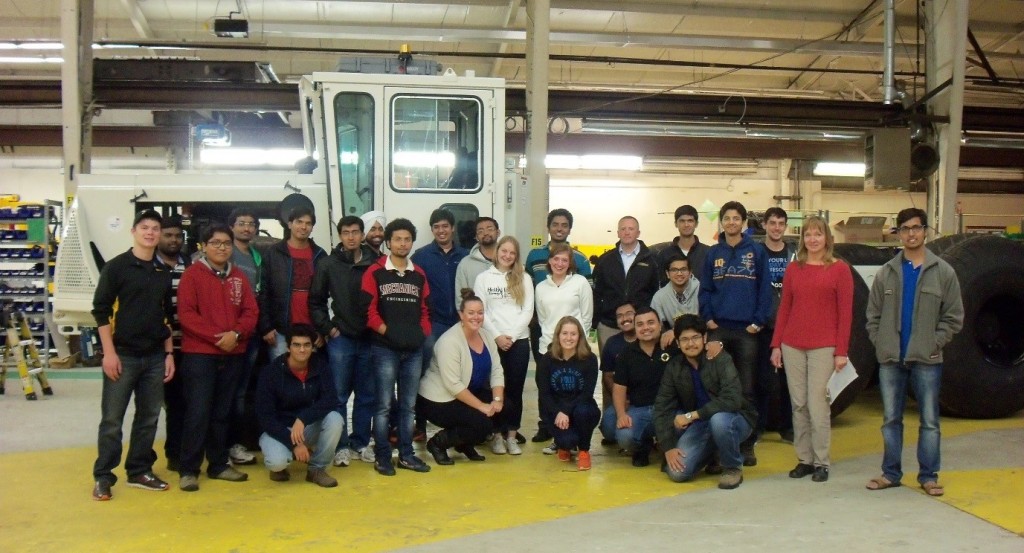
The Office of Continuous Improvement at Michigan Tech is creating an immersive environment for our students to learn about Lean to the mutual benefit of the university, students, employers, and the local community. The university uses Lean in its everyday operations, provides Lean education for students, and coaches students on using Lean in their student organizations and community service. Over the last eight years, Michigan Tech has held over 200 improvement events, all designed to get students in the classroom with calm minds, ready to learn and faculty in their labs with a calm mind, ready to do their research.
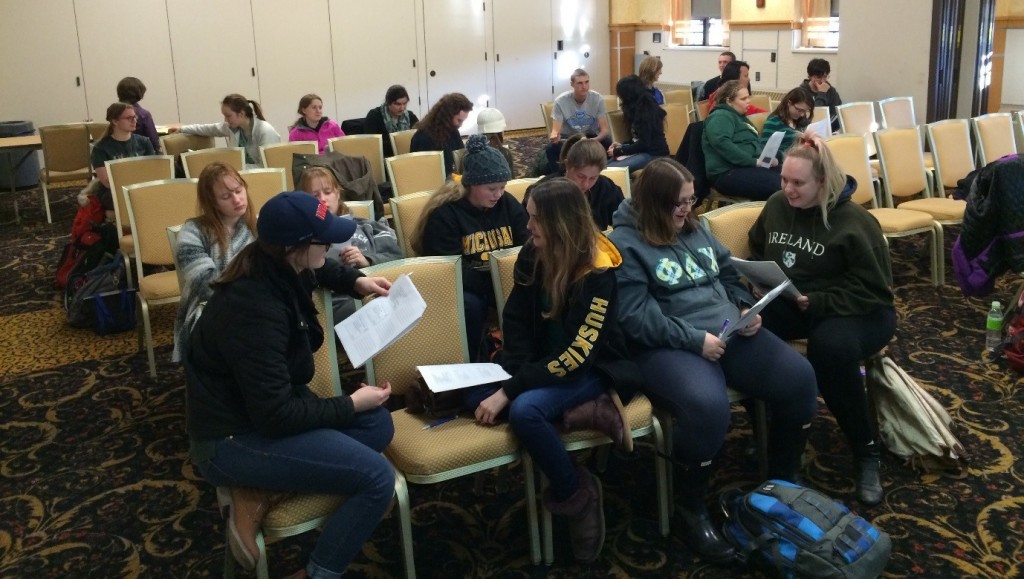
Michigan Tech students engage in Lean in many ways. There are several academic courses students can take on Lean principles, Lean culture, and Lean manufacturing, as well as courses on concepts related to Lean, like change management, teamwork, project management, and safety. As a member of the student organization Leaders in Continuous Improvement (LCI), students learn about Lean and practice their skills working with other student organizations and local non-profits. Students have opportunities on campus to attend Lean workshops, take online short courses on Lean principles, request facilitators for improvement events in their student organizations and enterprises, receive coaching on certification preparation, and participate on kaizen as customers or outside eyes. With many departments on campus actively practicing Lean, students with on-campus jobs are exposed to Lean tools and processes like daily huddles, standard work, and visual management. Finally, students encounter and practice Lean during internships and co-ops with industry.
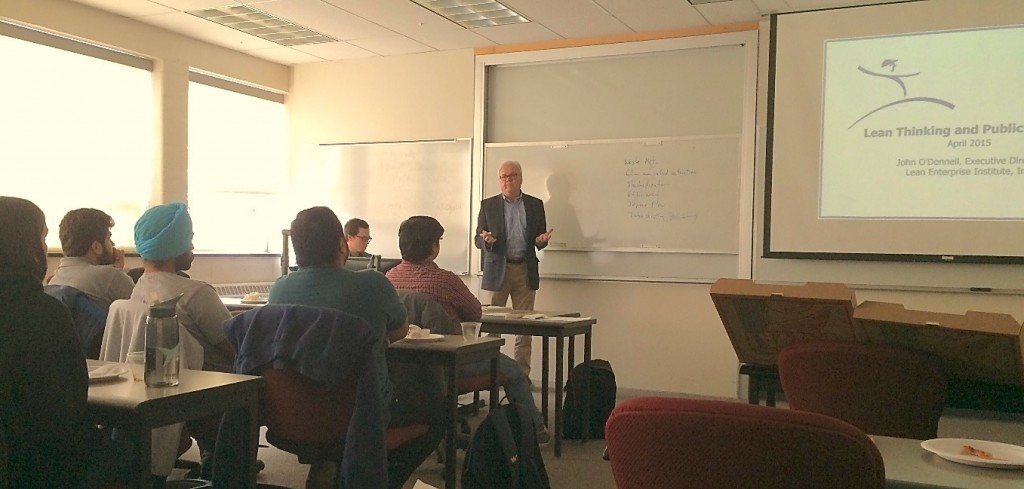
Imagine a world where everyone understands the importance and benefits of quality! Our vision is for every student graduating from Michigan Tech to learn about quality and continuous improvement at some level. We want to meet students where they are at with a full range of engagement possibilities tailored to their unique needs. Look around our website to see how the Office of Continuous Improvement is engaging students, faculty, staff, and the local community in the learning and practice of Lean and continuous improvement. How can industry help? By increasing our students’ awareness of Lean practices in your organization, offering internships that require Lean skills, inviting our students for a tour of your facility or participation in your kaizen, and volunteering as a guest speaker at an LCI meeting.
